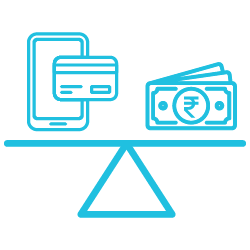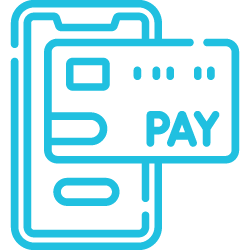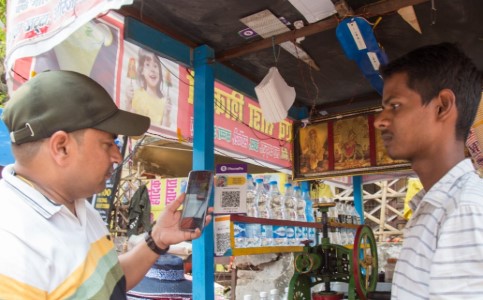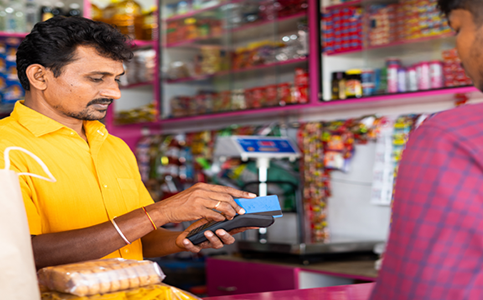Consolidated progress chart of all payment instruments


1390%
Digital payments and cash compared to India’s GDP
As of Mar ’24

19%
Currency in circulation compared to India’s GDP
As of Mar ’25

6%
Drop in cash as a preferred mode for e-commerce payments
As of 2023

1,013 Mn
Smartphone users in India
As of 2023

903 Mn
Mobile internet subscriptions in India
As of Mar ’25

21.5 GB
Wireless data usage per user in India
As of Jun ’24

38 Mn
Aadhaar(s) issued in India
As of Mar ’2417.2 Mn
Business correspondents (BCs) in India
As of Mar ’242,994 Mn
Worth of transactions conducted by BCs in 2024
As of Mar ’24720 Mn
Basic Savings Bank Deposit Accounts opened till date
As of Mar ’24

550 Mn
PMJDY beneficiary accounts in India
As of Mar ’25

378 Mn
RuPay debit cards issued to PMJDY beneficiary accounts
As of Mar ’25

130,330
Scheduled commercial bank branches in India
As of Mar ’24990 Mn
Debit cards currently in circulation
As of Mar ’25

110 Mn
Credit cards currently in circulation
As of Mar ’251.3 Bn
Prepaid instruments (PPIs) currently issued to users
As of Jun ’25

215,700
Operational ATM machines in India
As of Mar ’24

1.4 Mn
Operational microATM machines in India
As of Mar ’25

11 Mn
Operational PoS machines in India
As of Mar ’25

664 Mn
Operational static and dynamic UPI QRs in India
As of Mar ’25USD 30 Bn
Worth of monthly cash withdrawals done
As of Mar ’252,233,000
Billers live on BBPS
As of Mar ’256
Existing e-RUPI use-cases
As of Mar ’24Quarterly insights
Quarterly insights
Aadhaar-enabled Payment System (AePS)
Surge in the adoption of AePS face authentication among women
- Recent data from the PayNearby Women Financial Index (PWFI) 2025 shows that 40% of female Aadhaar Enabled Payment System (AePS) users now use face authentication for cash withdrawals at retail banking points. Women in rural and semi-urban areas increasingly prefer face authentication over fingerprint biometrics as they face challenges with fingerprint recognition due to manual labor or age.
- This shift indicates the role AePS face authentication plays in enhancing both the accessibility and security of AePS transactions, and in supporting greater financial inclusion for women and vulnerable groups.
AePS sees persistent stagnation in transaction value and volumes
- April 2025 witnessed a sharp 14% month-on-month decline in AePS transaction volume, which fell from 570 million transactions to 489 million transactions in March 2025. The value of AePS (Aadhaar Enabled Payment System) transactions similarly dropped by 13% to INR 266 billion (USD 3.1 billion) in April, compared to INR 305 billion (USD 3.5 billion) in March.
- These declines follow a temporary spike in March, which industry analysts explain with the timing of government subsidies and welfare disbursements, a recurring seasonal pattern in AePS usage.
- Off-us interoperable transactions remain low. In March 2025, only 228.5 million of the total 570.7 million transactions were off-us, which indicates that most AePS activity is now on-us, a reversal from the earlier trend of growing interoperability.
Interoperability and incentive challenges continue to constrain the long-term growth potential of AePS
- Many large public sector banks remain reluctant to fully enable off-us AePS (Aadhaar Enabled Payment System) transactions. Many banks require customers to choose off-us transactions, which often necessitates a branch visit. This limits the original promise of AePS as a universally interoperable platform and particularly affects migrant and rural users who may not have access to their bank’s business correspondents (BCs).
- On-us transactions now dominate AePS activity, which reflects banks’ preference for internal BC networks. Banks have doubled their on-us AePS volumes over the past three years. This allows them to retain interchange fees and maintain greater control over customer experience and data. While this supports profitability and compliance, it reduces convenience and reach for end-users, especially those in remote areas.
Quarterly insights
Prepaid Payment Instruments (PPIs)
RBI enables UPI interoperability for full-KYC PPI wallets via third-party apps
- In a landmark move to enhance interoperability and user convenience, the Reserve Bank of India (RBI) announced in December 2024 that users of full-KYC prepaid payment instruments (PPIs), such as digital wallets, gift cards, and metro cards, can now make and receive UPI payments through third-party mobile applications, such as Google Pay and PhonePe.
- Previously, UPI transactions from PPIs were limited to the wallet issuer’s own app. Now, wallet holders can link their full-KYC PPI wallets to any UPI-enabled app, authenticate through existing PPI credentials, and transact seamlessly across platforms.
- The move brings PPI wallets on par with bank accounts and RuPay credit cards for UPI interoperability. It fosters competition and innovation in the payments ecosystem. Industry experts highlight this as a significant step toward a unified digital payments environment, with the RBI’s Payments Vision 2025 explicitly targeting such interoperability to drive digital adoption and financial inclusion.
A sharp decline in PPI wallet numbers amid regulatory actions and dormancy cleanup
- Despite regulatory advances, the PPI wallet segment has seen a significant contraction in active wallet numbers. As per RBI data, the total number of PPI wallets dropped by 20.4% year-to-date, from 1.44 billion in January 2024 to 1.14 billion in November 2024.
- The year-on-year decline stands at 16.7%, with the drop largely attributed to regulatory action against Paytm Payments Bank and Airtel Payments Bank, which together saw wallet counts fall by 42% and 48.5%, respectively, over the year. Industry experts also note that many dormant or inactive wallets were deactivated as part of a sector-wide cleanup, which contributed to the decline.
- In contrast, non-bank FinTechs, such as PhonePe, MobiKwik, Ola Financial Services, and Amazon, have continued to grow their wallet bases. PhonePe leads at 211.82 million wallets in November 2024, followed by MobiKwik (141 million) and Ola Financial Services (79.71 million).
Growth in PPI cards, even as wallet numbers fall
- While wallet numbers declined, PPI cards have continued to grow, albeit from a smaller base. The number of outstanding PPI cards reached 416.35 million at the end of November 2024. This marked a 30.7% year-on-year increase and a 26.9% rise since January 2024. This shift suggests a growing preference for card-based prepaid solutions among consumers and businesses, possibly for gifting, travel, and corporate expenses.
- In April 2025, UK-headquartered FinTech major Revolut received full authorization from the RBI to issue domestic prepaid cards and wallets in India, which included UPI-enabled wallets. Revolut’s entry is expected to intensify competition and bring global best practices to the Indian PPI landscape, especially as the company targets tech-savvy and internationally mobile consumers.
- The contraction in wallet numbers reflects a sector maturing under tighter regulatory scrutiny, with a focus on active, full-KYC users and the elimination of dormant accounts. The growth in PPI cards and the entry of global players, such as Revolut, signal ongoing innovation and diversification in the prepaid segment, even as the market consolidates around compliant, customer-centric offerings.
Quarterly insights
Unified Payments Interface (UPI)
The NPCI mandated weekly mobile number deactivation checks to curb fraud and enhance security
- In March 2025, the National Payments Corporation of India (NPCI) circulated a new compliance requirement for all UPI participants—banks and third-party apps must now synchronize their databases with the Department of Telecommunications’ Mobile Number Revocation List (MNRL) every seven days.
- This measure prevents UPI IDs from being linked to recycled or inactive mobile numbers—a known vector for fraud and erroneous transactions. The circular requires explicit user consent for mobile number seeding and periodic updates. This will ensure that users are aware and in control of their transaction credentials.
- The move is largely significant for rural and semi-urban markets, where mobile number churn is higher and digital literacy is still developing.
The NPCI restricted pull-based UPI transactions to verified merchants to address rising fraud risk
- In March 2025, the National Payments Corporation of India (NPCI) announced a phased restriction on pull-based UPI transactions—commonly known as “collect” requests—to reduce fraud.
- Only large, verified merchants can now initiate pull-based payment requests on UPI. Person-to-person (P2P) collect requests are capped at INR 2,000 (approx. USD 23) per transaction. This measure is in direct response to the increasing number of scams where fraudsters send deceptive collection requests to trick users into authorizing payments for non-existent goods or services.
- This regulatory shift encourages both users and merchants to adopt push-based transactions, such as QR code payments. Such transactions are inherently more secure as they are user-initiated and give the payer complete control over the transaction. Officials have emphasized that push transactions minimize the risk of social engineering and accidental approvals, which are more prevalent in pull-based models.
- This regulatory intervention aligns with the government’s broader vision of securing digital payments. It is expected to significantly reduce the incidence of UPI-related fraud and reinforce users’ trust in the platform.
UPI expanded its global reach with new cross-border corridors and collaborations
- Following the successful India-Malaysia PayNet linkage, NPCI International Payments Limited (NIPL) has signed an Memorandum of Understanding with Qatar to enable QR based UPI payments across the country. It also seeks to engage with Southeast Asian countries, such as Thailand and Vietnam, to roll out UPI-based remittances and merchant payments by Q3 2025.
- The expansion targets Indian travelers and small and medium enterprises (SMEs). It offers instant INR conversion and lower remittance costs. This aligns with the government’s vision to make UPI a global payment standard.
- The NIPL is also collaborating with countries, such as Peru, Namibia, and Trinidad and Tobago, to help them develop domestic real-time payment systems similar to UPI.
Quarterly insights
BHIM Aadhaar Pay (BAP)
The NPCI issues new guidelines for merchant acquisition on BHIM Aadhaar Pay
- On 8th May 2024, the National Payments Corporation of India (NPCI) issued new guidelines for the acquisition of merchants on the BHIM Aadhaar Pay (BAP) platform. These guidelines seek to streamline the onboarding process and ensure that merchants comply with the necessary security and operational standards.
- NPCI’s new guidelines include requirements for biometric authentication devices, transaction limits, and compliance with data protection regulations. This move is expected to enhance the reliability and trustworthiness of the BHIM Aadhaar Pay system, which encourages more merchants to adopt this digital payment solution.
Challenges in the AePS may affect BAP’s adoption
- The Aadhaar Enabled Payment System (AePS) has encountered a high transaction failure rate of about 34%. These challenges are mainly due to biometric mismatches, connectivity issues, and insufficient balances. These issues hinder users’ ability to pay through BHIM Aadhaar Pay (BAP), since AePS is its underlying system.
- Biometric authentication in AePS may also exclude segments, such as illiterate demography, the elderly, or people with disabilities, which can potentially limit BAP’s reach. Additionally, concerns about taxes and fees in AePS may affect BAP’s adoption indirectly as it impacts agents’ income and poorer rural populations.
- AePS transactions have declined due to users’ preference for other payment methods, such as United Payments Interface (UPI). This poses potential challenges for BAP’s usage.
- Innovative solutions and regulatory measures that address authentication issues are needed to ensure BAP’s continued success. The integration of offline authentication services, such as UPI Lite with AePS, can enhance reliability and user experience and increase BAP’s adoption.
BAP faces competition from other payment instruments
- Traditional payment cash and United Payments Interface (UPI)-based offline transactions through QR codes, such as UPI Tap & Pay, continue to give stiff competition to BHIM Aadhaar Pay (BAP). Customers prefer these for P2M (person-to-merchant) payments. UPI Tap & Pay enables fast and seamless transactions with just a tap from the user’s phone on the merchant’s near-field communication (NFC) reader. In comparison, BAP requires the customer to complete biometric authentication to complete their transaction successfully.
Quarterly insights
Cash
Rural demand and consumption fuel the rise in currency circulation
- India’s total currency in circulation reached INR 38.1 trillion (USD 442 billion) as of 2nd May 2025. This marked a 2.4% year-to-date increase, higher than the 1.7% growth seen in the same period last year. This growth is largely driven by strong rural demand, which has been supported by robust farm output and favorable agricultural commodity prices. Notably, this increase in cash usage has continued despite the absence of a national election cycle, which typically boosts cash demand.
- Cash remains a dominant mode of payment in India. As of March 2024, it accounts for about 60% of consumer expenditures, even as digital payments infrastructure continues to expand. Over the past decade, currency in circulation more than doubled. During this time, the number of ATMs grew by 32% and bank branches by 36%. This shows the continued importance of cash in the Indian economy.
- Since January 2025, the Reserve Bank of India has injected more than USD 70 billion into the banking system. This aggressive cash injection has shifted the banking system’s liquidity from deficit to surplus. Banks parked an average of INR 2 trillion (USD 23.36 billion) overnight with the RBI in April, up from INR 750 billion (USD 8.76 billion) in January. The system recorded a surplus of INR 894 billion (USD 10.42 billion) on 30th March 2025— the highest in over three months. These measures have helped moderate borrowing costs and prevent further slowdown in economic growth.
Revised ATM fee structure comes into effect from 1st May 2025
- Effective from 1st May 2025, the Reserve Bank updated the ATM framework, increased the fee for out-of-bundle withdrawals to INR 23 per transaction. Previously, this fee was INR 21 per transaction. Customers continue to receive five free transactions per month at their own bank’s ATMs. Additionally, they receive three free transactions at other banks’ ATMs in metropolitan centers and five in non-metro areas. This fee structure is uniform across commercial, rural, cooperative, white-label ATMs and cash recycler units, while interchange charges are set by the respective ATM networks.
Despite UPI’s growth, cash usage remained resilient
- While UPI transaction volumes surpassed 185 billion transactions worth INR 260 trillion in FY 2024–25 (USD 3.04 trillion), the demand for physical currency has remained remarkably resilient. Annual ATM cash withdrawals have averaged around INR 33 trillion since FY 2018–19, and the value of currency in circulation has doubled since 2017. This shows that although digital payments have expanded financial inclusion, cash still plays a vital role in everyday transactions, where infrastructure, trust, or regulatory issues limit the shift to electronic payments.
Quarterly insights
National Electronic Funds Transfer (NEFT)
NEFT maintains a strong growth momentum with more than. 856.8 million transactions in January 2025
- The National Electronic Funds Transfer (NEFT) system continued its stellar performance in early 2025. In January 2025, it processed approximately 856.8 million transactions. This sustained high volume reflects NEFT’s ongoing role as a critical instrument for digital payments in India, which supports a broad spectrum of retail and business transactions, such as salary disbursements, vendor payments, and routine fund transfers.
- The consistently high transaction volumes highlight NEFT’s reliability, 24×7 availability, and widespread adoption countrywide. The system’s scale and efficiency underscore the trend of accelerating digital payment adoption and the ongoing shift away from paper-based transactions in India’s financial ecosystem.
RBI mandates beneficiary account name look-up facility for NEFT to enhance transaction security and user confidence
- The Reserve Bank of India (RBI) has directed all banks participating in the National Electronic Funds Transfer (NEFT) system to implement a beneficiary account name look-up facility by 1st April 2025. This move is designed to reduce unintended transfers and curb fraud by enabling remitters to verify the beneficiary’s account name before completing a transaction.
- When initiating a NEFT transfer—whether through Internet banking, mobile banking, or at a bank branch—the remitter will enter the beneficiary’s account number and IFSC code. The system will then fetch and display the beneficiary’s name as recorded in the destination bank’s Core Banking Solution (CBS), which will then allow the sender to confirm the recipient’s identity before proceeding.
- This feature will be available during new payees’ registration, one-time fund transfers, and recertification of existing beneficiaries. If the beneficiary’s name cannot be displayed, the remitter may still proceed with the transaction at their discretion. However, they will receive a specific alert message as per the RBI and NPCI guidelines. The beneficiary name look-up facility will be free for all NEFT customers. The RBI has mandated that both direct and sub-member banks make this feature available across digital channels, such as internet and mobile banking, and at physical branches.
- This initiative allows customers to verify the beneficiary’s name before sending funds. Thus, it is expected to significantly reduce the risk of misdirected payments, typographical errors, and social engineering fraud, especially in high-value or business-critical transactions. The RBI’s move aligns NEFT with UPI and IMPS, which already offer similar name verification features. This move is part of the central bank’s broader efforts to strengthen trust and integrity in India’s digital payment infrastructure.
Microfinance institutions (MFIs) and banks drive massive volumes
- Almost all MFIs in India now use cashless modes to disburse loans to their customers, with 88% of loan disbursements in MFIs are through the National Electronic Fund Transfer (NEFT) system. The constant growth in the MFI loan portfolio, which recorded a 20.3% year-over-year (YoY) growth in FY 2023, directly impacts NEFT’s performance.
- Traditionally, repayments in the MFI industry are made through group meetings, as the core borrower base is more comfortable with cash payments. However, many MFIs have been exploring recollection methods through digital channels when cash collection is not possible. These digital channels include Unified Payment Interface (UPI), NEFT, or Bharat Bill Payment System (BBPS).
- Only a small section of customers have adopted NEFT as a repayment channel. On the other hand, UPI is a popular repayment channel against MFI loans. The nonliterate customer segment perceives UPI and BBPS as more seamless and effortless digital repayment channels than NEFT or other net banking and mobile banking channels.
Quarterly insights
*99# (USSD-based mobile banking service)
USSD saw a sharp year-on-year decline in transaction value and volume
- As per the National Payments Corporation of India’s (NPCI) product statistics, USSD (Unstructured Supplementary Service Data) transactions saw a sharp 25.9% year-on-year decline in volume and a 32.6% drop in value between March 2024 and March 2025. This trend highlights USSD’s diminishing role in India’s payments ecosystem. The decline is largely driven by rapid smartphone penetration, widespread UPI adoption, and the rise of alternatives, such as IVR-based (interactive voice response) “Hello! UPI”, for feature phone users.
USSD’s low profit margin for different stakeholders led to further disinterest
- The USSD service incurs costs, such as short message service (SMS) and payment service provider (PSP) fees. At present, telecom operators bear these costs. However, they are unwilling to continue these services for free. Meanwhile, the National Payments Corporation of India (NPCI), is hesitant to pass these expenses on to banks, as their profit margins on USSD payments are already minimal. This limited profitability has become the primary reason for waning interest among stakeholders.
Hello! UPI can replace USSD as a feature phone-friendly payment system
- The core pillar of Hello! UPI is based on the interactive voice response (IVR) model. This payment mode does not require tech-heavy interaction from users. It can enable payments through a phone call. Hello! UPI can find its place in the market that Unstructured Supplementary Service Data (USSD) once sought, as feature phones allow basic call functions.
Quarterly insights
National Automated Clearing House (NACH)
The NPCI mandated an enhanced online cancellation, amendment, and suspension facility for all banks
- The National Payments Corporation of India (NPCI) has introduced Key changes to the National Automated Clearing House (NACH) mandate management process. These significant changes have a strong focus on customer empowerment and digital convenience. As per the updates, it has set a strict deadline for all participating banks to provide customers with a seamless online facility. So that they can cancel, amend, suspend, and revoke (CASR) NACH mandates through digital channels, such as bank websites and apps. Customers can now temporarily suspend a mandate and later revoke the suspension to resume payments. This will provide them with greater flexibility to manage recurring obligations.
- Banks that fail to comply risk being deboarded from the Online Mandate Generation System (ONMAGS). This would prevent them from accessing NACH e-mandate processing. Banks are now mandated to update their digital infrastructure and user interfaces to meet the new standards, and strict consequences are issued against non-compliance.
- These steps address longstanding customer pain points in canceling or modifying mandates for recurring payments, such as SIPs (systematic investment plans), loan EMIs (equated monthly installments), and insurance premiums. The CASR overhaul marks a significant leap in customer control over recurring payments, which reduces friction and enhances trust in digital mandates.
The NPCI introduced new product and transaction codes for government DBT and credit transactions
- The National Payments Corporation of India (NPCI) has announced the implementation of new product types and transaction codes for NACH, which came into effect from 1st April 2025 onwards. These product types and transaction codes seek to streamline the processing of Direct Benefit Transfer (DBT) and other government payments. Specifically, transaction code “83” with the header code “33” and product type “BDC” will be used for select DBT flows. In contrast, transaction code “84” with the same header and product type “LAU” is designated for additional government-linked credit transactions. Additionally, the product type “COR” has been created to facilitate specialized credit flows, which enables more precise categorization and reconciliation of government and welfare payments across participating banks.
- All member banks must update their systems and processes to be able to integrate these new codes, with updated file naming conventions and technical specifications outlined by the NPCI.
- The new transaction codes will help government departments and banks better track, reconcile, and audit DBT and credit flows and support financial inclusion and welfare delivery.
The NPCI enabled simplified Aadhaar authentication for e-mandate registration
- The National Payments Corporation of India (NPCI) has enabled simplified Aadhaar-based authentication for e-mandate registration. Customers, especially those without access to net banking or debit cards, can now seamlessly set up recurring payments.
- Under this new framework, customers can authenticate e-mandates through their Aadhaar number and a one-time password (OTP) sent to their Aadhaar-linked mobile number. This removes the need for net banking or debit cards. The newly introduced framework makes recurring payment setup easier and accessible to a wider segment of the population, targeting those in rural and semi-urban areas. The process has strong security encryption, which requires explicit customer consent before authentication. It also ensures that all data exchanges are encrypted per UIDAI (Unique Identification Authority of India) and NPCI standards.
- This NPCI’s initiative marks a significant step toward universalizing digital recurring payments in India. The e-mandate process now uses Aadhaar and OTP-based authentication and is thus more inclusive, user-friendly, and secure. It is expected to drive greater adoption of automated payments, reduce friction for underbanked segments, and support the broader digital financial inclusion agenda.
Quarterly insights
e-RUPI - Prepaid e-voucher
e-RUPI voucher issuance rose sharply in February 2025, but redemption remained low
- February 2025 witnessed a sharp rise in the issuance of e-RUPI vouchers by leading public sector banks. Despite this, actual redemption rates remained low. Indian Bank led the surge and generated 507,550 e-RUPI vouchers in February, a nearly five-fold increase from 110,625 vouchers in January. The State Bank of India (SBI) followed with 126,810 vouchers, also up from 106,084 in the previous month. This sharp uptick reflects renewed institutional and government interest in the use of e-RUPI for targeted benefit delivery and welfare programs.
- Despite the issuance surge, these vouchers’ actual use remains low. Indian Bank recorded a redemption rate of just 4%, while the SBI’s rate stood at 6.5% for February. This means that only a small fraction of the distributed vouchers were redeemed by beneficiaries during the period, which highlights a gap between distribution and end-user adoption. The low redemption rates may point to several underlying challenges:
- Beneficiaries may lack awareness of ways to redeem vouchers at merchant locations or face hurdles in the process.
- Limited merchant infrastructure or onboarding for e-RUPI could be restricting redemption opportunities.
- The redemption process may require further simplification to encourage uptake, especially among less digitally literate users.
- The surge in voucher creation demonstrates institutional confidence in e-RUPI, which is relied on as a tool for targeted, leak-proof benefit transfers. Additionally, the persistently low redemption rates signal the need for greater beneficiary education, streamlined redemption processes, and expanded merchant acceptance. Stakeholders must address these gaps for e-RUPI to fulfill its promise as an efficient and inclusive digital benefit delivery mechanism.
Several Indian banks offered incentives to boost the RBI’s e-RUPI transactions
- Indian banks have been introducing various incentives to increase the volume of transactions through e-RUPI. These incentives are similar to those offered for credit and debit card usage. They range from cashback to reward points, funded by the banks.
- HDFC Bank, India’s largest private lender, has sent out offers for its customers to promote e-RUPI transactions. However, the bank did not disclose specific details of these offers. Meanwhile, smaller banks, such as Yes Bank and IDFC FIRST Bank, have been providing reward points redeemable for travel bookings, mobile recharges, and cashback via FASTag.
- Other major banks, such as ICICI Bank and Union Bank, are expected to follow a similar trend with incentives. Proactive efforts by banks could fuel the growing usage of India’s central bank digital currency (CBDC) even further.
The RBI expanded e-RUPI voucher issuance to individuals for wider accessibility
- The Reserve Bank of India (RBI) announced its intent to allow e-RUPI voucher issuance on behalf of individuals. The RBI highlighted the need to simplify the issuance and redemption processes and other aspects of the existing framework in the discussions that followed the RBI’s Monetary Policy Committee (MPC) meeting.
- This step is expected to broaden the accessibility of e-RUPI digital vouchers to a larger user base and promote digital payment penetration countrywide.
Quarterly insights
Credit card
The RBI rolled out measures to enhance transparency and strengthen consumer protection
- The RBI has continued to tighten regulations to promote transparency and consumer protection. Effective 1st January 2025, lenders must update credit bureau records every 15 days instead of monthly. This would ensure a more timely reflection of credit behavior in borrowers’ credit scores. The RBI also mandates clear disclosure of charges, responsible lending practices, and enhanced security protocols, which include tokenization of card data for digital transactions.
- SBI Card and other issuers have revised their rewards programs and benefits for the new financial year, which reduces reward rates on select categories and discontinues some complimentary insurance covers. These changes reflect an industry-wide move to balance customer incentives with profitability amid rising costs and regulatory scrutiny.
Credit card spending in India reaches new highs, but growth moderates
- Credit card spending in India hit a record INR 21.16 lakh crore (USD 254.82 billion) in FY25. This marks a significant 15% year-on-year increase from INR 18.32 lakh crore (USD 214.26 billion) in FY24. This surge was driven by strong consumer demand, greater adoption of electronic transactions, and the convenience of credit-backed purchases, especially among urban, digitally savvy users. March 2025 alone saw a record monthly spend of INR 2.02 trillion (USD 23.62 billion), up from INR 1.64 trillion (USD 19.18 billion) in March 2024. However, after a peak in December 2024, spending moderated, with a 2.1% drop in January 2025 and further declines in February. This reflected seasonal factors, such as tax planning and the end of the festive season.
- While credit card usage remains strong, recent months have seen moderate growth due to several reasons. These include seasonal factors, increased household debt, and economic headwinds, such as equity market volatility. The average spend per transaction reduced in February 2025, and both point-of-sale and e-commerce payments declined from January levels. Nevertheless, the long-term outlook remains positive, with projections of continued double-digit annual growth in card-based transactions as digital adoption deepens and financial inclusion expands.
While credit card base expanded, new issuance lost momentum
- The number of credit cards issued reached nearly 108.9 million by March 2025, up from 101.8 million a year earlier. This represents a 9.5% annual growth. The industry added 820,000 new cards in January 2025, led by HDFC Bank, SBI Cards, and ICICI Bank, which together accounted for nearly 90% of new issuances. However, new card issuance slowed sharply in February 2025, with only 0.82 million cards added. This reflects an increased caution among smaller issuers due to rising delinquencies and stricter RBI risk-weight regulations. Year-on-year growth in card numbers and spending remains positive, but has slowed since June 2021.
- HDFC Bank remains the market leader with a 21.7% share and 23.8 million cards in circulation as of March 2025, followed by SBI Card at 19.0%, ICICI Bank at 16.6%, and Axis Bank at 13.6%. Bank of Baroda recorded the highest annual growth in the credit card segment at 23%, while Kotak Mahindra Bank saw an 18% decline, partly due to a temporary RBI ban on new card issuance, which was lifted in February 2025.
Quarterly insights
Debit card
Debit card transactions and usage decline as UPI and credit cards increase
- India’s debit card landscape is experiencing a marked shift as transaction volumes and values declined over the past year. In February 2025, debit card transactions dropped 9% in volume and 7% in value month-on-month. Moreover, year-on-year figures show a sharper decline of 17% in volume and 10% in value. This trend is part of a broader pattern: FY23-24 saw a 33% drop in debit card transaction volume and an 18% reduction in spending compared to the previous year. The number of debit cards in use is forecast to rise modestly by 8% through 2029, but this growth is muted relative to previous years and the rapid expansion in credit cards and UPI.
- The decline in debit card usage is primarily attributed to the explosive growth of UPI, which offers ease of use, instant settlement, and a zero merchant discount rate (MDR) for small and medium merchants. Consumers and merchants increasingly prefer UPI for everyday transactions. This has diminished the role of debit cards for retail payments. Additionally, the lack of compelling reward programs and limited awareness of existing benefits have further reduced debit cards’ appeal, especially when compared to credit cards, which now offer more attractive incentives.
- Despite these trends, debit cards remain a crucial payment tool, particularly for ATM withdrawals. In February 2025, 80.5% of debit card transactions were ATM withdrawals, while only 14.5% occurred at point-of-sale (PoS) terminals and 5% in e-commerce. The total value of debit card transactions for the month stood at INR 2.68 billion (USD 31.1 million), with 87.2% from ATMs, 8.7% from PoS, and 4.1% from e-commerce.
Public sector banks maintain dominance in debit card issuance
- Public sector banks continue to hold the majority share in debit card issuance. As of late 2024, State Bank of India (SBI) led with 23.76% of all debit cards, followed by Bank of Baroda at 10.13% and Canara Bank at 5.94%. SBI also reported a 10% year-on-year growth in debit card issuance. Among private sector banks, Axis Bank and HDFC Bank saw the highest growth rates at 15% and 10%, respectively.
The RBI rolled out regulatory updates and enhanced security measures for debit cards
- The Reserve Bank of India (RBI) has introduced several measures to enhance debit card security and user control. Cardholders can now set transaction limits for domestic and international use. They must separately activate services, such as international transactions, e-commerce, and contactless payments. These changes seek to curb cyber fraud and give users greater flexibility and security. The RBI’s “Payments Vision 2025” also emphasizes the expansion of digital payment options. It intends for debit card usage to surpass credit cards in value. However, recent trends show this goal remains challenging given the current trajectory.
Quarterly insights
Immediate Payment Service (IMPS)
NPCI reports 100% uptime for the IMPS platform through FY 2024-25
- From April 2024 to April 2025, the National Payments Corporation of India (NPCI) maintained 100% operational uptime for the Immediate Payment Service (IMPS) platform with zero incidents of unscheduled downtime. This marks the first fiscal year with uninterrupted service since IMPS’s launch in 2010. The achievement reflects upgrades in the NPCI’s infrastructure, which include redundancy protocols and real-time monitoring systems.
- Consistent uptime reinforced IMPS’s position as India’s most reliable 24/7 real-time payment rail. As of April 2025, it processed INR 6.2 lakh crore (USD 74.7 billion) monthly across 449 million transactions.
NPCI introduced a simplified IMPS rule for transactions up to INR 500,000 (USD 6,000) through mobile number and bank name
- The National Payments Corporation of India (NPCI) has simplified the Immediate Payment Service (IMPS) process. Now, users can send up to INR 500,000 (USD 6,000) without the beneficiary’s account number and IFSC code. They can do so through the beneficiary’s mobile number and bank name alone. This update enhances the efficiency of money transfers and their ease of use. The updated IMPS process also includes real-time beneficiary name validation, which improves security and reduces the risk of erroneous transfers. This streamlined process will benefit retail and corporate users and simplify high-value transactions.
The NPCI introduced the UDIR system to streamline complaint handling for IMPS
- The National Payments Corporation of India (NPCI) introduced the Unified Dispute and Issue Resolution (UDIR) system to streamline complaint handling for Immediate Payment Service (IMPS) transactions. This system serves as a bridge for member banks and allows them to connect their internal systems. They can also manage customer disputes and queries through application programming interface (API) calls.
- Remitter banks must link their customer management systems to the UDIR system at the NPCI to raise disputes. Mentioned as per the new guidelines issued in the NPCI’s circular to all members of the IMPS network. They must also communicate transaction and complaint status changes to customers through customer management systems (CMS), mobile apps, Internet banking, SMS, and email.
- This initiative seeks to improve customer complaint resolution for IMPS transactions. It will ensure a smoother and more efficient process for both remitter and beneficiary banks.
Quarterly insights
Bharat Bill Payment System (BBPS)
Bharat Connect introduced enhanced information requirements for cross-border wire transfers
- In April 2025, Bharat Connect introduced new compliance requirements for cross-border wire transfers. The requirements make KYC and AML standards robust for international bill payments.
- All Bharat Connect operating units must now capture and transmit detailed remitter information for cross-border transactions. This must include the remitter’s full name, payment mode, bank account or equivalent, and a valid government-issued ID, such as PAN, passport, or Aadhaar.
- These requirements align Bharat Connect with the RBI’s updated KYC Master Directions and international anti-money laundering (AML) standards, ensuring a higher level of compliance and risk mitigation. This also enhances transparency and auditability for cross-border bill payments, supports smoother regulatory reviews, and reduces the risk of fraudulent or suspicious transactions.
NPCI rolled out the Unified Presentment Management System (UPMS) for the biller and mobility categories
- In November 2024, NPCI Bharat BillPay Ltd. implemented UPMS across all BBPS biller categories. It includes additional feature enablement for FASTag and National Common Mobility Card (NCMC) billers in February 2025. UPMS provides a standardized, real-time platform for bill presentment, which enables consistent bill formats, notifications, and reminders across all digital channels. This reduces confusion for end-users and streamlines integration for billers and operating units.
- The February 2025 circular specifically enabled UPMS features for FASTag toll and NCMC (National Common Mobility Card) transit billers. It supports dynamic, usage-based billing and real-time fare calculation for commuters. This is a significant step toward digitizing India’s transit and mobility payments ecosystem.
- UPMS is designed to handle high transaction volumes and enables rapid onboarding of new biller categories. It supports the future growth of the BBPS ecosystem.
NPCI Bharat BillPay Ltd. launched Bharat Connect QR to digitize offline collections and streamline bill payments
- On 21st October 2024, NBBL introduced the Bharat Connect QR, a standardized QR code solution designed to convert offline bill collections into seamless digital transactions and enhance new customer onboarding for BBPS billers.
- Bharat Connect QR operates on a “Scan, Fetch, and Pay” principle. Customers can scan the QR code provided by the biller, which instantly fetches the latest bill details through the Biller Operating Unit (BOU). The customer can then pay the bill directly within their BBPS-enabled app. This makes the payment journey more intuitive and frictionless, ensuring that any customer-facing app can read and process any biller’s QR code. This step promotes interoperability and a consistent user experience across the BBPS ecosystem.
- The Bharat Connect QR is expected to accelerate the migration of cash-based bill payments to digital channels, particularly in regions and sectors where offline collections remain prevalent. It uses QR technology’s familiarity and convenience to make bill payment onboarding instant and app-agnostic, supporting new customer acquisition.
Quarterly insights
Cheque Truncation System (CTS)
The RBI proposes a continuous cheque-clearing system to accelerate payment processing and enhance efficiency
- The Reserve Bank of India (RBI) announced its plan to implement a continuous clearing system for cheques with “on-realization-settlement” in the Cheque Truncation System (CTS). This is designed to significantly reduce the clearing cycle to just a few hours from two working days. It can potentially revolutionize the speed and efficiency of cheque-based transactions in India.
- Under this proposed system, cheques will be processed continuously during business hours, while scanning, presentation, and clearing will occur within hours of submission. This marks the end of the current batch processing mode, which operates on a T+1 day cycle. The RBI anticipates this change will accelerate payment processing and improve overall transaction efficiency, which benefits both payers and payees.
- The implementation of this continuous cheque clearing is expected to yield multiple benefits, which include improved clearing efficiency, reduced settlement risk for participants, and an enhanced customer experience.
The rise in the value of CTS transactions indicates that people primarily use cheques for high-value payments, such as settlements and large purchases
- The value of Cheque Truncation System (CTS) transactions in India rose significantly in 2023. They reached approximately INR 5.84 trillion (USD 70 billion) in October 2023, up from INR 3.85 trillion (USD 46 billion) in June 2020. The average monthly value of CTS transactions during this period was around INR 5.64 trillion (USD 67 billion).
- This increase in CTS transaction value and decrease in the volume of CTS transactions suggest a growing preference for cheques in high-value payments, such as settlements and large purchases.
- CTS lacks the immediacy of Real-Time Gross Settlement (RTGS) or National Electronic Fund Transfer (NEFT). Customers typically prefer these modes for large transactions. However, the value of transactions via CTS is notably higher than those made through credit cards, debit cards, and Immediate Payment Service (IMPS).
PNB mandated the Positive Pay System for cheques valued more than INR 500,000 (USD 6,014)
- Punjab National Bank (PNB) took a significant step to enhance the security of cheque payments. It mandated the Positive Pay System (PPS) for cheques valued at INR 500,000 (USD 6,014) and above from 5th April 2023.
- The National Payments Corporation of India (NPCI) developed PPS to add an additional layer of security. It requires customers to reconfirm crucial details, such as the account number, cheque number, three-digit cheque alpha code, issue date, amount, and beneficiary name, when it issues cheques valued at more than INR 500,000 (USD 6,014). Customers can conveniently use the PPS facility through various channels. These include branch offices, online banking for individuals and businesses, mobile banking through the PNB ONE app, and SMS banking. Customers should submit these details one working day before the cheque presentation or clearing date.
- For the dispute resolution mechanism, it will only accept cheques registered in the PPS. This move reduces the previously mandated threshold, which was set at INR 1 million (USD 12,017) and above. PNB’s mandatory implementation of the PPS for high-value cheques will enhance security, reduce fraudulent cheque payments, and provide added protection for customers.
-
AePS
-
PPIs
-
UPI
-
Credit Card
-
Debit Card
-
IMPS
-


BBPS
-
CTS
-
BAP
-
Cash
-
NEFT
-
*99#
-


NACH
Drag an instrument’s icon from the carousel above and drop it into any of the three boxes to compare them
Use the checkboxes to select and compare up to three instruments
You can click on any of the elements in the legend above to show or hide the corresponding instrument
Drag an instrument’s icon from the carousel above and drop it into any of the three boxes to compare them
Use the checkboxes to select and compare up to three instruments
You can click on any of the elements in the legend above to show or hide the corresponding instrument
Drag an instrument’s icon from the carousel above and drop it into any of the three boxes to compare them
Use the checkboxes to select and compare up to three instruments
You can click on any of the elements in the legend above to show or hide the corresponding instrument
Resources

Digital payments in India—democratizing financial services for the masses
See more
Digital payments in India—unlocking an opportunity worth USD 10 trillion
See more
Conversational Payments on UPI: Unlocking new frontiers for next-generation payments
See more
Building an ecosystem of collections through BBPS
See more
How can digital public infrastructure improve government-to-person payments?
See more
The evolution of payments in India—looking ahead
See more
How do we envision digital payments beyond 2022?
See more
Retail digital payments in India: A massive opportunity worth at least INR 45 billion (USD 608 million)
See more
How digital payments drive financial inclusion in India
See more
Digital payments in India—democratizing financial services for the masses
See more
Digital payments in India—unlocking an opportunity worth USD 10 trillion
See more
Conversational Payments on UPI: Unlocking new frontiers for next-generation payments
See more
Building an ecosystem of collections through BBPS
See more
How can digital public infrastructure improve government-to-person payments?
See more
The evolution of payments in India—looking ahead
See more
How do we envision digital payments beyond 2022?
See more
Retail digital payments in India: A massive opportunity worth at least INR 45 billion (USD 608 million)
See more

